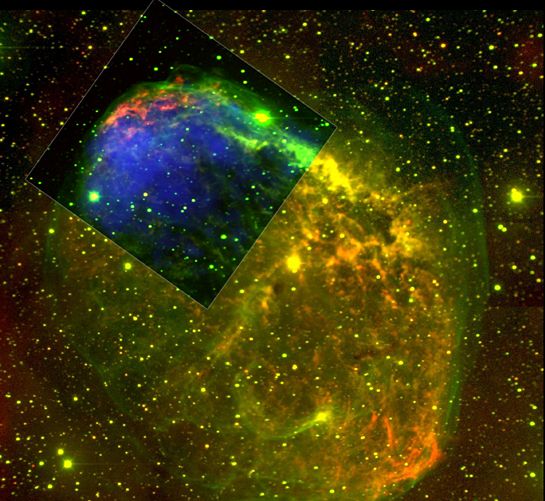Credit & Copyright: Y.-H. Chu & R. Gruendl
(Univ. Illinois) et al.
X-ray; CXO / NASA, Optical; SDSU / MLO
Explanation:
NGC 6888, also known as
the Crescent Nebula, is
a cosmic bubble of interstellar gas about 25 light-years across.
Created by
winds from the bright, massive star seen near the center
of this composite image, the
shocked filaments of gas glowing at optical
wavelengths are represented in green and yellowish hues.
X-ray
image data from a portion of the nebula viewed by
the Chandra Observatory is overlaid in blue.
Such isolated
stellar wind
bubbles are not usually seen to
produce
energetic x-rays, which require
heating gas to a million degrees celsius.
Still, NGC 6888 seems to have accomplished this
as slow moving winds from the central star's initial transition
to a red supergiant
were overtaken and rammed by faster
winds driven by the intense radiation from the star's
exposed inner layers.
Burning fuel
at a prodigious rate and near the end
of it's stellar life, NGC 6888's central star
should ultimately go out with a bang, creating a supernova
explosion in 100,000 years or so.
NGC 6888 is about 5,000 light-years close, toward the constellation
Cygnus.
X-ray; CXO / NASA, Optical; SDSU / MLO
1999 2000 2001 2002 2003 2004 2005 2006 2007 2008 2009 2010 2011 2012 2013 2014 2015 2016 2017 2018 2019 2020 2021 2022 2023 2024 2025 |
Yanvar' Fevral' Mart Aprel' Mai Iyun' Iyul' Avgust Sentyabr' Oktyabr' Noyabr' Dekabr' |
NASA Web Site Statements, Warnings, and Disclaimers
NASA Official: Jay Norris. Specific rights apply.
A service of: LHEA at NASA / GSFC
& Michigan Tech. U.
|
Publikacii s klyuchevymi slovami:
stellar wind - Crescent Nebula - massive stars - rentgenovskoe izluchenie - zvezdnyi veter - Tumannost' Polumesyac - massivnye zvezdy
Publikacii so slovami: stellar wind - Crescent Nebula - massive stars - rentgenovskoe izluchenie - zvezdnyi veter - Tumannost' Polumesyac - massivnye zvezdy | |
Sm. takzhe:
Vse publikacii na tu zhe temu >> | |
